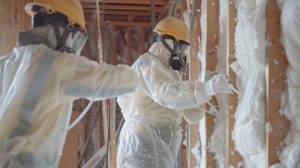Insulation degrades over time, and this degradation can lead to a variety of problems. For example, old cellulose may contain outdated fire retardants that can release harmful fumes, and it might be contaminated with asbestos.
Old insulation can also attract pests and create a breeding ground for mold and allergens. If you’re experiencing any of the following problems, your home’s insulation likely needs to be replaced.

High Energy Bills
Insulation is essential for controlling energy use, reducing heating and cooling costs, and creating a more comfortable home environment. When old insulation begins to degrade, however, it can lead to higher energy bills and reduced energy efficiency.
Insulating a home with new, high-quality materials and professional installation is an affordable way to improve energy efficiency and reduce utility bills. As a result, homes with upgraded insulation can save money in the long run and increase their resale value.
Studies have shown that homes with effective insulation experience fewer temperature fluctuations and are more likely to sell faster than other similarly priced properties. Upgrading insulation in older homes is also a smart investment as it can help reduce environmental impact and potentially lower energy costs for future homeowners, making them a more attractive buying option.
Regular home inspections are a great way to identify areas where improved insulation is needed. For example, if some rooms are hotter or colder than others, or if your energy bill suddenly rises, these are indications that the insulating material is outdated or damaged and needs to be replaced.
Uncomfortable Temperatures
When your home is well-insulated, you’ll enjoy lower energy bills and greater comfort. You won’t have to worry about air leaks and the formation of ice dams, and you won’t be exposed to harmful gases from old fiberglass insulation (which can release VOCs).
Uneven temperatures can indicate that your home’s insulation isn’t distributed evenly or has lost its effectiveness over time. Unexpectedly rising energy bills can also be a sign that your insulation is outdated and needs to be replaced.
Upgrading your insulation with spray foam or other eco-friendly options can enhance your home’s resale value. Potential buyers will appreciate the energy efficiency and comfort of your home, and you’ll save money on heating and cooling costs in the meantime.
Poor Indoor Air Quality
Poor indoor air quality can be a serious health issue, causing headaches and irritation of the eyes, nose, and throat. It’s also been linked to chronic diseases like respiratory problems and cancer.
Hazardous pollutants in indoor air include carbon monoxide from combustion sources, volatile organic compounds such as formaldehyde from new furniture or a newly painted room, and mold and other biological contaminants. In addition, deteriorating fiberglass insulation can release airborne fiberglass fibers that are inhaled.
When choosing insulation, consider eco-friendly options that are free of flame retardants and other harmful chemicals. The right insulation can be effective in improving indoor air quality, reducing energy bills, and helping to maintain a comfortable temperature. Get your attic inspected, air sealed, and upgraded with spray foam or another product that will help seal gaps and prevent moisture and air leaks to improve the indoor environment and your overall health! We’ll remove old, ineffective, and unhealthy insulation, air seal all the places where pests, air, and moisture enter your home, and then install new, high-quality insulation that will make your home more comfortable, healthy, and efficient.
Allergens
Allergies can be triggered by a variety of factors, including pollen, pet dander, dust mites, and mold. These allergens can settle in attic insulation and move through airflow into living spaces, causing respiratory problems and exacerbated allergy symptoms. Modern insulation blocks moisture, inhibits mold growth, and reduces spore releases, all of which help prevent the infiltration of airborne allergens into the home.
Old types of insulating materials may contain volatile organic compounds (VOCs) and release them into the air as they break down. Upgrading to modern insulation eliminates this issue and ensures the safety of your family’s health and comfort.
In addition to upgrading your insulation, it’s important to monitor pollen counts and follow a few simple tips to mitigate allergies during peak season. Limiting exposure to irritants, staying hydrated, and practicing stress management can make all the difference. If your allergies are particularly severe, talk to a healthcare professional for personalized advice and solutions. Our insulation specialists can remove old attic insulation, air seal gaps and openings where pests, air, and moisture can enter, and professionally install new energy-efficient insulation that improves indoor air quality while reducing your heating and cooling costs.
Mold
Mold in the home can contribute to a host of health problems, including respiratory symptoms, fatigue, headaches, and depression. These symptoms are caused by mycotoxins, or toxins produced by fungi and yeasts that grow in damp environments, like those found in poorly insulated homes. These toxins are also known to aggravate existing asthma symptoms and may even cause new-onset asthma in some individuals.
As old insulation degrades, it can create gaps in the wall that allow outdoor air to enter the house. This air can bring unpleasant odors, bacteria, and other pathogens into the home, causing an influx of pollutants.
Insulation material plays a crucial role in determining indoor air quality. Fiberglass insulation, for instance, can release small respirable fibers into the air if it isn’t properly installed or maintained. These particles are breathed in unintentionally, irritating the nose and throat over time. Similarly, cellulose insulation, which is made from recycled materials, can release mold spores into the air if it is wet. It is best to invest in energy-saving insulation services that use non-toxic materials.